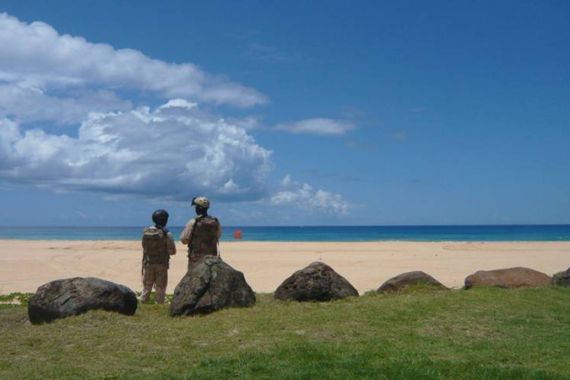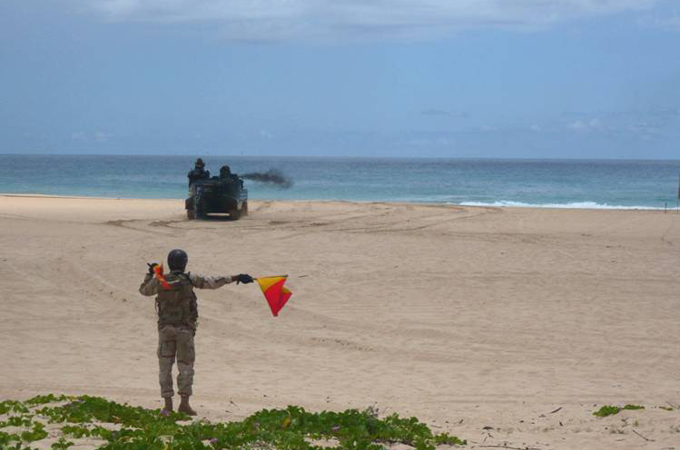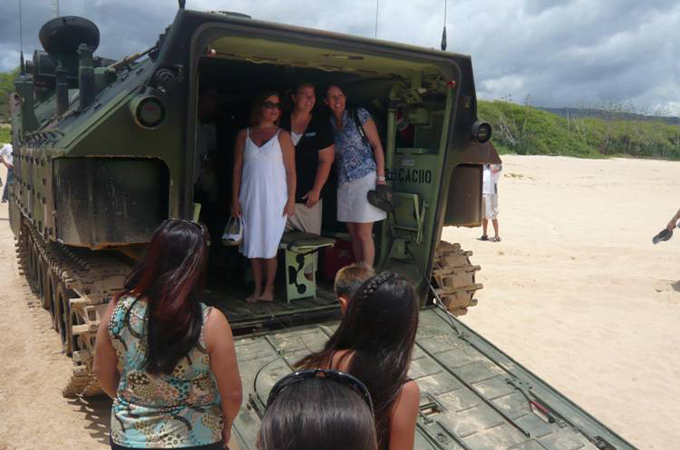Without question: US military expansion in the Asia-Pacific
The expansion of the US military into Asia-Pacific is not just about power, but also about profit.

Kauai, Hawaii – As Noam Chomsky wrote in this two-part essay, the US “pivot” towards the Asia-Pacific region is in response to what it calls “classic security dilemmas” posed by the rising influence of China and Russia. Reacting with military programmes and strategies it says are “defensive”, this “pivot” is perceived as bullying, threatening and an intrusion – in other words more of the same – by those most impacted by US foreign military presence.
The “classic security dilemma makes sense”, Chomsky argues, if one operates under the assumption that the US has “the right to control most of the world, and that US security requires something approaching absolute global control”.
A major component of this “pivot” is its pursuit of “missile defence” which both President Obama and presumed Republican nominee Mitt Romney argue are intended to counter threats from Iran and North Korea. Critics call it a ruse, but most of the US public calls it nothing at all – the issue is barely on the radar.
Even as the US clings to 20th century notions of being the world’s “sole super power”, attempting to expand its influence and control over Asia-Pacific’s power centres, shipping lanes and resources, the US public remains under-informed, indifferent and flat-out unaware of its military impact abroad.
In a recent Wall Street Journal opinion piece, Romney wrote: “Security in the Pacific means a world in which our economic and military power is second to none.” He continued: “The sum total of my approach will ensure that this is an American, not a Chinese century.” Not long after, Romney called Russia: “[America’s] number one geopolitical foe.”.
Wanted: Enemy number one
If President Obama’s tone is more nuanced, his actions differ little from Republicans. Announcing a new US military expansion in Australia in autumn 2011, Obama declared: “The United States is a Pacific power, and we are here to stay.”
In a November 2011 article entitled “America’s Pacific Century”, Secretary of State Hillary Clinton detailed US plans to bolster its military presence in the region. “America’s near-future work in Asia will proceed along six key lines of action”, Clinton wrote, one being “forging a broad-based military presence”.
Claiming that it is the United States which “maintains peace and security, defends freedom of navigation and ensur[es] transparency”, Clinton emphasised the importance of the Asia-Pacific’s economic development, trade routes, resources and investment opportunities for the US.
The Asia-Pacific’s “remarkable economic growth … and potential for continued growth,” she wrote, “depend on the security and stability that has long been guaranteed by the US military, including 50,000 American servicemen and servicewomen serving in Japan and South Korea.”
According to Clinton, the US must “pursue a more geographically distributed, operationally resilient, and politically sustainable force posture” – in other words, a larger military presence.
 |
| An amphibious assault vehicle makes landfall at Major’s Bay at the Pacific Missile Range Facility on the Hawaiian island of Kauai during Rim of the Pacific (RIMPAC) military exercises in 2008 [Jon Letman/Al Jazeera] |
Hawaii’s role in all this is enormous. Hawaii represents a fraction of one per cent of the United States’ land area and has just 1.37 million people, but is home to 119 military sites, effectively making Hawaii a giant floating military garrison, from which troops and military hardware are dispatched around the world.
Not a dozen miles from tourist-packed Waikiki Beach is Camp HM Smith, headquarters of the United States Pacific Command (USPACOM) which oversees military operations in roughly half the world, from the Bering Sea to the Antarctic and across the entirety of the Pacific Ocean as far west as Central Asia, Pakistan and the southern Indian Ocean. More than half the world lives within USPACOM’s “area of responsibility”, including China, India, Indonesia, Japan – and 32 other countries.
Yet despite Hawaii’s huge military presence, there’s little visible resistance – nothing like Okinawa where, in April 2010, 90,000 Okinawans protested in the streets to call for the removal of the Futenma US Marine airbase, a show of power which contributed to the downfall of then-Prime Minister Yukio Hatoyama.
Since the end of World War II, Okinawans have borne the brunt of continuous US military occupation. More than half of all US forces in Japan are based in Okinawa prefecture. The main island of Okinawa, which is twenty per cent smaller and twenty times more populous than Hawaii’s Kauai island, has become an unfortunate symbol for the suffering of ordinary people as they are trampled on by both the US and Japanese governments. The almost seven decades of economic stranglehold, land seizures, traffic disruptions, automobile accidents, endless noise pollution, environmental damage, crime and sexual violence – a by-product of Okinawa’s 32 US bases and facilities – are well documented.
A base here, a base there…
As part of the US military realignment in Japan, it plans to transfer 4,700 Marines and their dependents to Guam, where the US military already occupies one-third of the Phuket-sized island with around three dozen military installations and some 14,000 troops. As recently as 2010, military environmental degradation had spawned at least 95 polluted or contaminated Air Force and Navy sites on Guam. The number of “Superfund” sites recognised by the US government for “uncontrolled hazardous waste” fluctuates from year to year.
Meanwhile, the department of defence “acquires” more land for the kind of military training activities, which one National Oceanic and Atmospheric Administration official dryly described: “The department of defence conducts training activities in Guam, which include underwater demolition and landing craft exercises, and these have the potential to impact Guam’s coastal waters and coral reefs negatively.”
Lisa Natividad, president of the Guahan Coalition for Peace and Justice, points out that Guam’s population suffers from cancer rates higher than the national average, a condition which local critics of the military say is related to high levels of copper, lead, mercury, zinc, PCBs, PAHs and other harmful heavy metals in Guam harbours and marine organisms. Natividad adds that Guam lies downwind of the Marshall Islands, where the US conducted 67 nuclear tests between 1946 to 1958.
Those atmospheric nuclear tests, callously given American-Indian tribal names such as “Cherokee” and “Navajo”, had a total yield of 108 megatons, equivalent to more than 7,000 Hiroshima-sized bombs. The tests made “Bikini Atoll” a household name as they literally “nuked” entire island communities and forced them to relocate permanently.
The Republic of the Marshall Islands, along with the Federated States of Micronesia and the Republic of Palau, is party to the Compact of Free Association (COFA), which grants the US military virtually exclusive use of a vast swathe of the Pacific for the transport, training and testing military personnel and weapons. Many COFA nationals live in Hawaii, where they are receiving medical treatment for cancer and other illnesses. However, in recent years, they have been embroiled in legal battles to continue receiving treatment as politicians at the state and federal level try to restrict or cut off government funded medical care.
Pacific islanders have also provided plenty of ripe, young bodies to feed into the US war machine (per capita, American Samoa, Guam and the Northern Mariana Islands have claimed military injuries and deaths in Iraq and Afghanistan at rates far higher than US states). In recent decades, the US has also conducted training and testing on Johnston Atoll, Wake Atoll, Kwajelein Atoll and the Mariana Islands, with a military presence in at least 23 small island groups in the Indo-Pacific region.
 |
| US civilians pose for photos inside an amphibious assault vehicle during a public event part of the 2008 Rim of the Pacific (RIMPAC) military exercises on the Hawaiian island of Kauai [Jon Letman/Al Jazeera] |
‘Peace Island’ no more
Today the Asia-Pacific “pivot” is most dramatically opposed on Jeju, a small Korean island just south of the peninsula, where coastal villagers in tiny Gangjeong are joined by activists from around the world in mounting an ongoing battle against the construction of a naval base designed to house US Aegis destroyers with the goal, critics charge, of containing China.
Jeju, which has three UNESCO World Heritage sites, is known as “peace island” and renowned for its unique environment and rich biodiversity. It is now threatened, as South Korea’s government complies with US pressure to build the base. Although Jeju’s struggle is still all but unknown by the broader US public, base opponents have gained support from Gloria Steinem, Robert Redford and Noam Chomsky, all of whom have spoken out against the militarisation of Jeju.
Recently, Bruce Gagnon, coordinator for the Global Network Against Weapons and Nuclear Power in Space, joined protesters in Gangjeong village, where he and others were arrested trying to stop construction. Gagnon says: “We saw a very determined and courageous village non-violently fighting to maintain their 450-year-old fishing and farming way of life … they understand that the US will use this as a key navy base in the pivot … to surround and control China.”
To the south, in 1992, the US was forced to close what was, at the time, its largest Asian naval base – at Subic Bay in the Philippines – after Filipino lawmakers voted against a new treaty allowing the base to remain open. However, the US still maintains around 600 Special Operations forces in the country as “advisers” and, in April, some 4,700 US troops participated in joint military exercises on Luzon and Palawan islands, near a disputed region of the South China Sea believed to be rich in gas and oil deposits and in one of southeast Asia’s most vital shipping lanes.
Also in April, the first deployment of an estimated 2,500 US Marines arrived in northern Australia, where a build-up is expected to continue until 2016. This increased US presence in Australia is said to include B-52 bombers, FA-18s, C-17 transport aircraft and nuclear powered submarines.
All this comes as Australian lawmakers discuss the potential of Cocos Islands as a future US drone base. The remote atoll – Australian territory, southwest of Indonesia – is being eyed as a base to monitor south Asia and the South China Sea. A drone base here would be attractive to the US, as it’s more than 2,400km closer to the South China Sea than the US naval base at Diego Garcia in the Indian Ocean. In the early 1970s, the entire indigenous population of the remote atoll was forcibly expelled to make way for that US naval base.
Beyond talk of Marines and drones, Australians are also asking themselves if US troops stationed in Australia would be subject to Australian laws or, as in other places, enjoy immunity under Status of Forces Agreements signed by the US and “host” nations.
This increase of US forces in the region comes as soldiers are freed up from previous “engagements” (wars) in Iraq and Afghanistan. But following the Kandahar massacre in March, in which a US soldier allegedly murdered 16 Afghan civilians and then burnt some of the bodies, one has to wonder how enthusiastic people will be about hosting US soldiers who may be arriving after serving three or four tours in those wars.
In contrast to protests against the military in Okinawa, Jeju and Guam, reaction to the military in Hawaii, with a few notable exceptions, typically ranges from indifference to ignorance and resignation and acceptance.
Here on Hawaii’s fourth largest island, Kauai, most people view its own military base – a naval facility named the Pacific Missile Range Facility (PMRF) – as a force for good and a source of much-needed jobs.
 |
| Hawaii’s beaches, famous for surf and sun, are also used for testing military hardware [Jon Letman/Al Jazeera] |
Drone on the range
PMRF is a missile defence testing facility, but has also been used as a training site for UAVs (Unmanned Aerial Vehicles) in collaboration with NASA, ostensibly for testing drone functions with the goal of developing drone imaging platforms for Earth resource monitoring. In August 2001, a giant drone named Helios set an unofficial world record when it reached an altitude of 96,000 feet (29,300m) after taking off from PMRF.
In 2011, PMRF was the launch site for the first test flight of an Advanced Hypersonic Weapon, which was directed at the Reagan Test facility on Kwajalein Atoll in the central Pacific. The November launch tested the ability to deliver aircraft at hypersonic speeds (Mach 5, or 3,600 mph or higher), presumably as part of the US stated goal of being able to strike offensively anywhere on Earth in 30 minutes.
PMRF also plays a vital role in the biennial Rim of the Pacific (RIMPAC), the world’s largest multi-national naval exercises. In 2010, fourteen nations and 20,000 personnel participated. RIMPAC 2012 (as always, in Hawaii) will begin in June and is expected to include testing of biofuels, underwater blue laser communications and possibly new UAV surveillance technology, in which drones are released from submarines then launched from the ocean’s surface.
PMRF has also been designated as a test site for the Aegis Ashore programme, a land-based component of the Ballistic Missile Defence System that complements the Aegis BMD sea-based system. Testing is planned for 2014, with deployment of Aegis Ashore in Romania slated for 2015, followed by Poland in 2018.
That PMRF is home to missile testing is no secret to local residents but it faces almost no opposition. On the contrary, it is considered a part of the community, an important economic driver and, for many, a proud symbol of how Hawaii contributes to the “defence of the nation”. The idea that a huge military presence in Hawaii might actually be unnecessarily making Hawaii a target is lost on most Americans or else dismissed with contempt as the naïve fantasy of tree-huggers and hippies.
To criticise, or even question, the enormous military footprint of the US at home and abroad is to invite derisive mockery and charges of being, at best, ungrateful and, at worst, a traitor. But not everyone is unaware or unsympathetic to America’s role in the Asia-Pacific region. In Hawaii, the US military has been compared to a gigantic octopus with tentacles twisting and turning in every direction. Here on Kauai, film maker Koohan Paik likens Hawaii’s dependency on the military to a household plagued by domestic violence. “It’s never discussed and we’re chastised for bringing it up,” says Paik. “We have to break the silence on geopolitical violence.”
What, me worry?
Rather than question an economy based on weapons, violence and control, the US public largely forfeits any protest in favour of the holy four-lettered word: Jobs. But the argument that the military and defence industry is an indispensable source of jobs is deflated when one reads a study by the Political Economy Research Institute at the University of Massachusetts, Amherst, which finds that $1 billion spent on military production creates 8,600 direct and indirect jobs. But that same amount of money invested in clean energy, health care or education could produce between 12,000 and 19,000 jobs.
This, however, is not a debate that is being waged within the wider citizenry. In fact, like the subjects of our foreign bases, drone warfare and the US military’s impact on people in the Asia-Pacific, it’s largely overlooked. In general, those in the US spend little or no time considering the plight of people in other nations – especially small islands – whose land, sea, ports and resources are used to test, train and store US military hardware and personnel. Whatever the costs may be to local populations in terms of environmental damage, social disruption, economic coercion and an increased danger simply by hosting US bases goes undiscussed.
Curiously, despite the fact that, in 2011, the US defence budget was well over $700 billion – far exceeding the combined defence budgets for China, Russia, India, Brazil, Saudi Arabia, Germany, France, the UK and Japan – a recent Rasmussen telephone survey reveals one in four US citizens believe the country is still not spending enough upon its military.
But as the Asia-Pacific “pivot” brings more testing, training and deployments to accommodate weapons and warriors fanning out across half the world, those in the US would do well to pay closer attention to the vast human and financial resources its government demands. The time is long overdue to consider that what we call “defensive” is, to so many around the world, seen as offensive.
As Bruce Gagnon said just prior to going to Jeju island: “This has nothing to do with defending the United States or its people against attack. It has everything to do with corporate profits and power.”
Jon Letman is an independent journalist in Hawaii, covering wildlife conservation, and the politics of the Pacific Rim.
Follow him on Twitter: @jonletman
